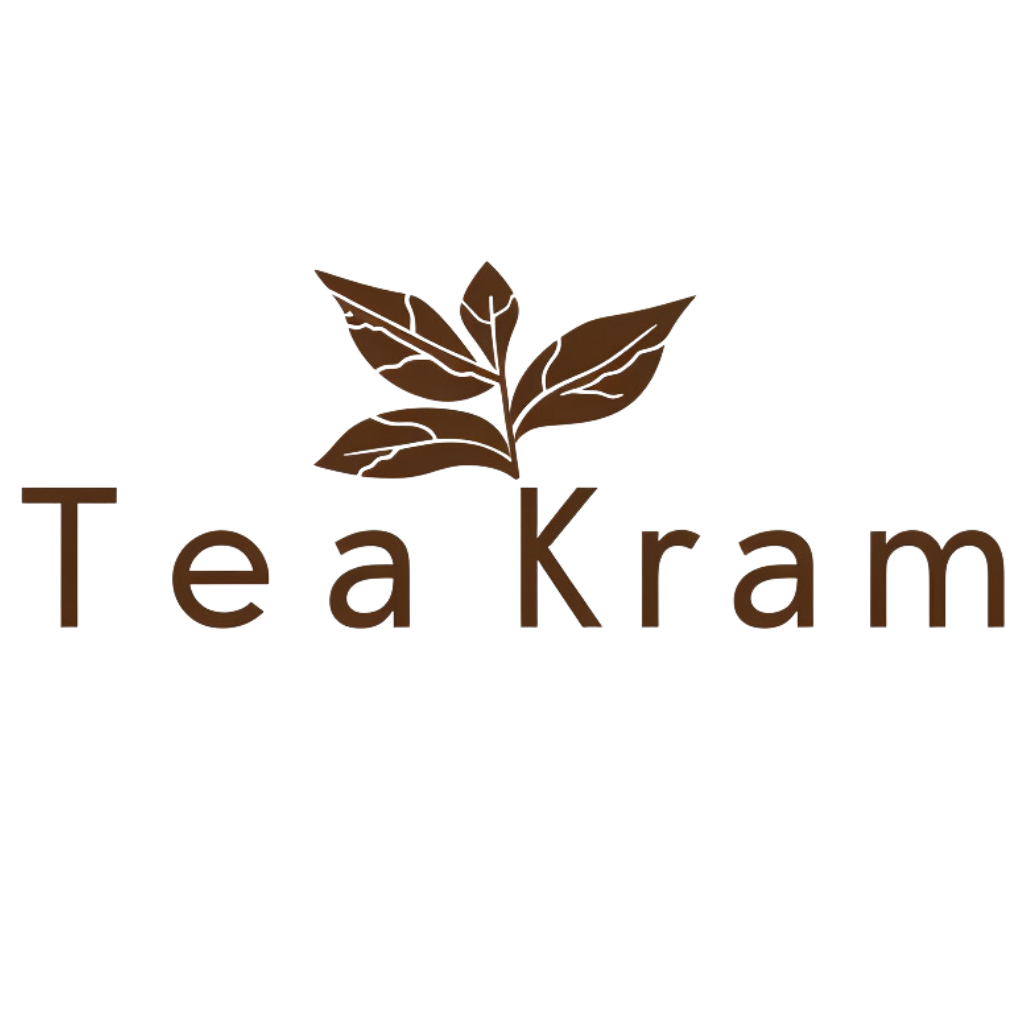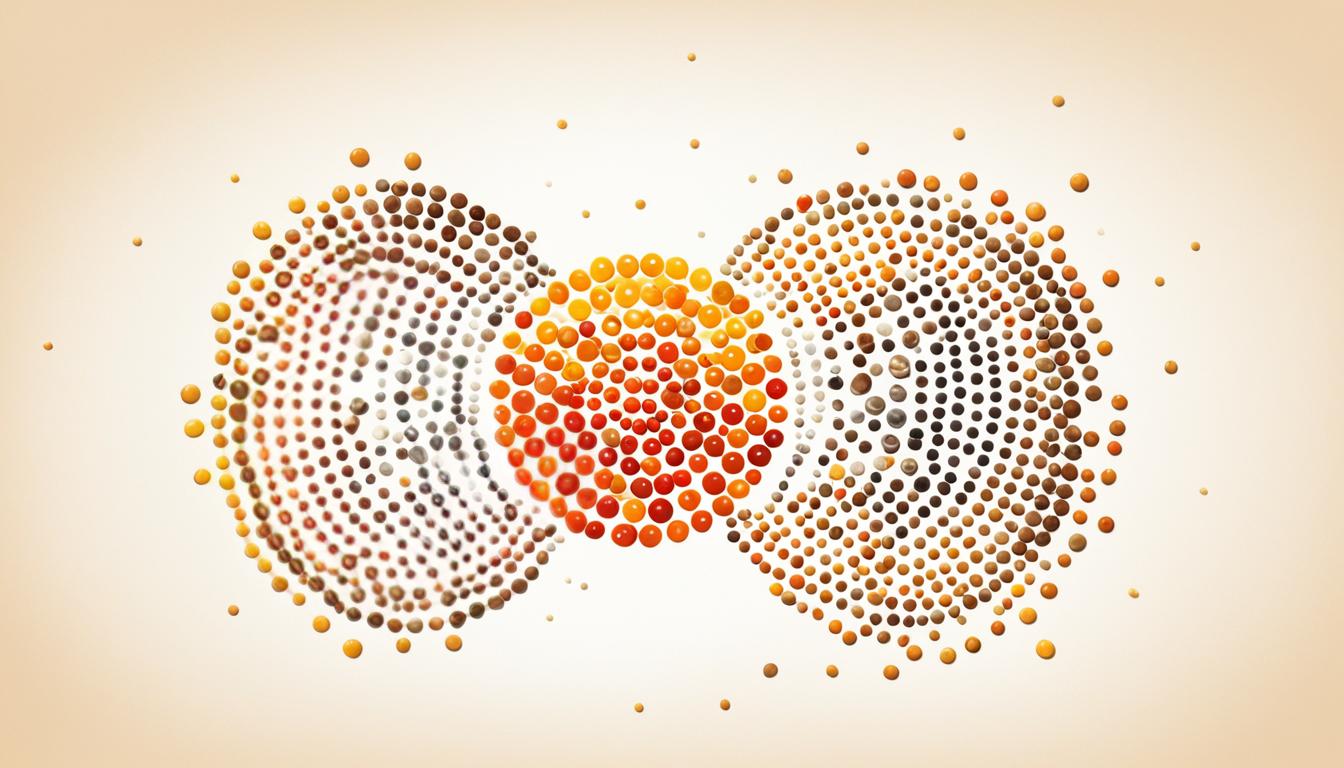Tea is more than just a soothing ritual for many. It’s also how they find their daily spark. Comparing caffeine levels in different teas are watched closely by those who monitor their intake. Black tea has the highest, with about 50 milligrams in a six-ounce cup. Meanwhile, white tea at 15-20 milligrams per cup is on the low end. So, how does this affect your tea choice? Let’s explore the caffeine world of tea together.
Key Takeaways
- Variation in caffeine levels allows tea drinkers to choose a brew that fits their energy needs.
- Black tea leads the pack in terms of caffeine, while white tea offers a milder boost.
- Herbal infusions provide options for those avoiding caffeine entirely.
- Specialty high-caffeine teas cater to those seeking a more substantial energy uplift.
- Decaffeinated teas present a compromise with significantly reduced caffeine content.
- The presence of L-theanine in tea creates a unique, steady alertness distinct from coffee.
Understanding Caffeine and Its Effects on the Body
Caffeine is key in making us feel awake each morning. It’s in our teas, playing a big role in our health and energy. People who care about health want to find the right balance. They like their tea to give them a boost but not harm their well-being.
What is Caffeine and Its Role in Tea?
Caffeine is a natural stimulant found in Camellia sinensis leaves. These leaves are used to make black, green, and white teas. People often talk about how much caffeine is in green tea vs black tea. Caffeine makes our nervous system more alert. It helps us stay focused and quick.
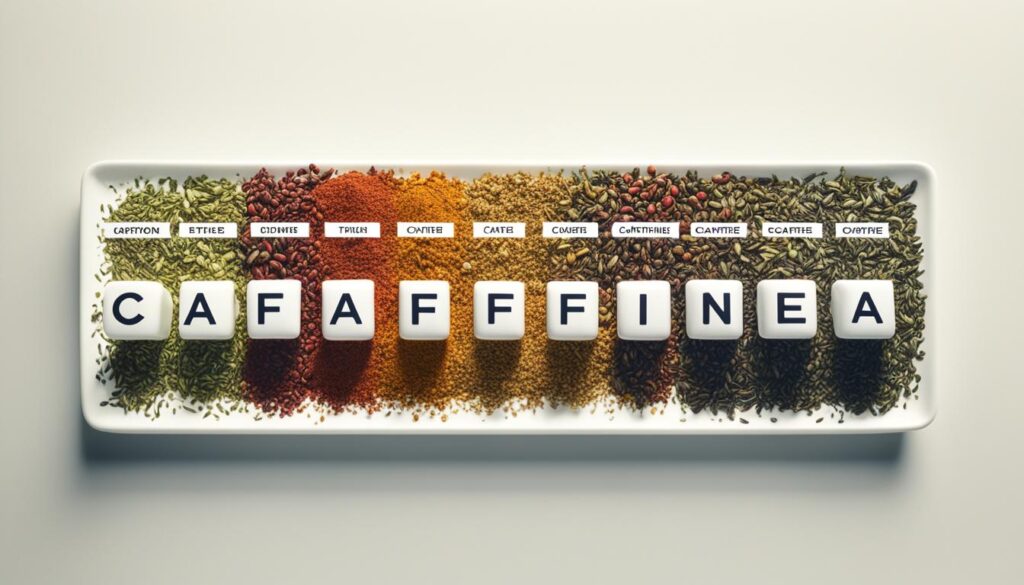
The Impact of Caffeine on Energy, Mood, and Health
Caffeine boosts our energy and helps our mood and brain work better. But, having too much can make us jittery or mess up our sleep. The FDA says up to 300 milligrams of caffeine daily is okay. That’s about six cups of black tea or ten cups of green tea.
How the Body Processes Caffeine from Tea Differently Than Coffee
Coffee and tea both make us feel more awake. But our body handles their caffeine differently. Tea has L-theanine, a compound that calms us without making us sleepy. This mix in tea gives us a smooth boost. It makes us alert without the sudden crash that coffee can cause.
Comparing Caffeine in Tea Types
When talking about caffeine in tea, people who love tea often look at the caffeine levels in different types. Each type of tea brings its own unique taste and amount of caffeine. This varies from black tea, with a strong flavor and lots of caffeine, to white teas that have just a little caffeine.
Black tea comes with the most caffeine due to its full oxidation. This process makes its flavor deeper and increases its caffeine. Then comes oolong tea, which has a wide range of caffeine because of how it’s oxidized and its leaf style. Green tea, known for its gentle flavors, has less caffeine and gives a softer boost. White tea has the least caffeine, great for those cutting down. And herbal teas have no caffeine, as they’re made from different plants, not the Camellia sinensis bush.
To really get the tea caffeine comparison, think about how brewing methods and steeping times change caffeine levels. Iced teas, mostly made from black tea, may have caffeine levels like hot teas, depending on preparation. This makes choosing your next cup of tea a bit more interesting, as the way it’s made matters.
| Tea Type | Caffeine Content | Typical Use | Notes |
|---|---|---|---|
| Black Tea | High | Morning/Afternoon | Fully oxidized for a robust flavor |
| Oolong Tea | Medium | Anytime | Partially oxidized with diverse flavors |
| Green Tea | Low | Morning/Daytime | Gently steamed or pan-fired |
| White Tea | Very Low | Anytime | Minimal processing for a delicate taste |
| Herbal Teas | None | Evening/Night | Caffeine-free options for relaxation |
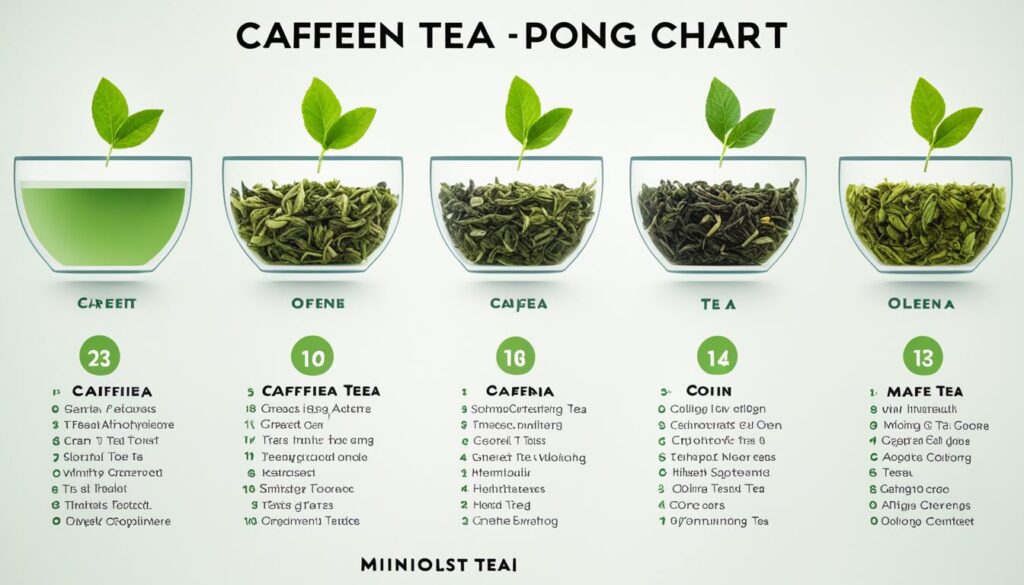
Factors Influencing Caffeine Content in Tea
Exploring tea shows how many elements affect its caffeine. Both experts and everyday drinkers find out how variety, growth, and making it impact its energy boost.
Tea Varietals and Their Natural Caffeine Levels
Different teas have different caffeine levels because of their genetics. The big-leaf Camellia sinensis var. assamica has more caffeine than the delicate Camellia sinensis var. sinensis. This is important for those choosing tea based on caffeine.
Effects of Harvest Time and Growing Conditions on Caffeine
When tea is picked and where it grows changes its caffeine. Tea from spring or shaded places, like Gyokuro, has more caffeine. These points are often talked about by tea lovers.
The Role of Processing Methods and Steep Times in Caffeine Extraction
The way tea leaves are processed can make a big difference. Cutting, rolling, or crushing can lead to more caffeine when brewed. Also, how you steep it – the water temperature and time – can change the caffeine level. This shows you can adjust tea’s caffeine by understanding how to make it.
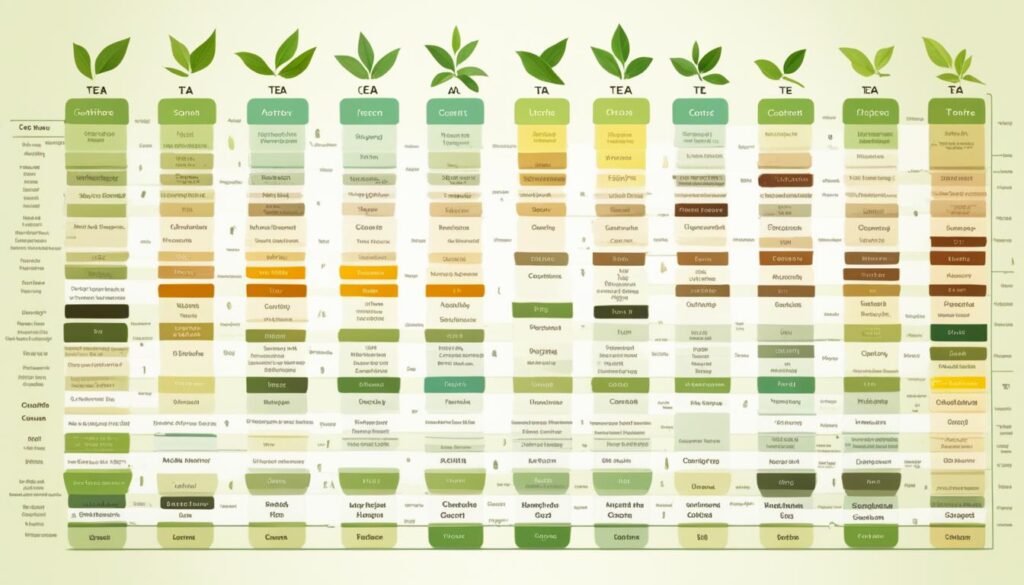
To wrap up, many things from plant genetics to how you make your tea affect its caffeine content. Knowing these factors helps enjoy your tea more, whether you want a light start or a strong energy boost.
Caffeine Levels in Popular Tea Categories
When you pick a tea, you think about its taste, smell, and how much caffeine it has. Each tea type, like comparing caffeine in tea types, has its own caffeine level. This is because of its making and brewing process. If you care about health, you might like caffeine in herbal teas. These teas usually have little or no caffeine.
An In-Depth Look at Black Tea Caffeine Content
Black tea is famous for its bold taste and high caffeine. It has about half the caffeine of coffee. But, the exact amount can change a lot. This depends on the tea’s variety and how it’s made.
Green Tea vs Black Tea Caffeine: Debunking Myths
People often say green tea has less caffeine than black tea. It’s true, but the difference might be small. The caffeine in green tea can sometimes be close to that in black tea. So, green tea drinkers might still get a caffeine boost.
White and Oolong Teas: Understanding Their Unique Caffeine Levels
White and oolong teas have special tastes and caffeine amounts. Oolong’s caffeine changes with how much it’s oxidized. White tea usually has less caffeine, but early harvests might have more. This shows why it’s vital to compare caffeine in tea types.
Below is a detailed chart showing how much caffeine is in different teas:
| Type of Tea | Average Caffeine Content per 8oz Cup (mg) |
|---|---|
| Black Tea | 40-70 |
| Green Tea | 20-45 |
| White Tea | 15-30 |
| Oolong Tea | 30-50 |
| Herbal Teas | 0 |
Tea lovers have many choices to fit their caffeine needs. You might like the strong boost from black tea or the calm from herbal teas. Exploring teas can be fun and exciting.
Decaffeinated and Herbal Teas: Exploring Caffeine-Free Options
Decaffeinated teas are popular among those who enjoy tea flavors without much caffeine. These teas are processed to have the lowest caffeine tea levels. Herbal teas naturally contain no caffeine. They offer health benefits and a range of aromatic experiences.
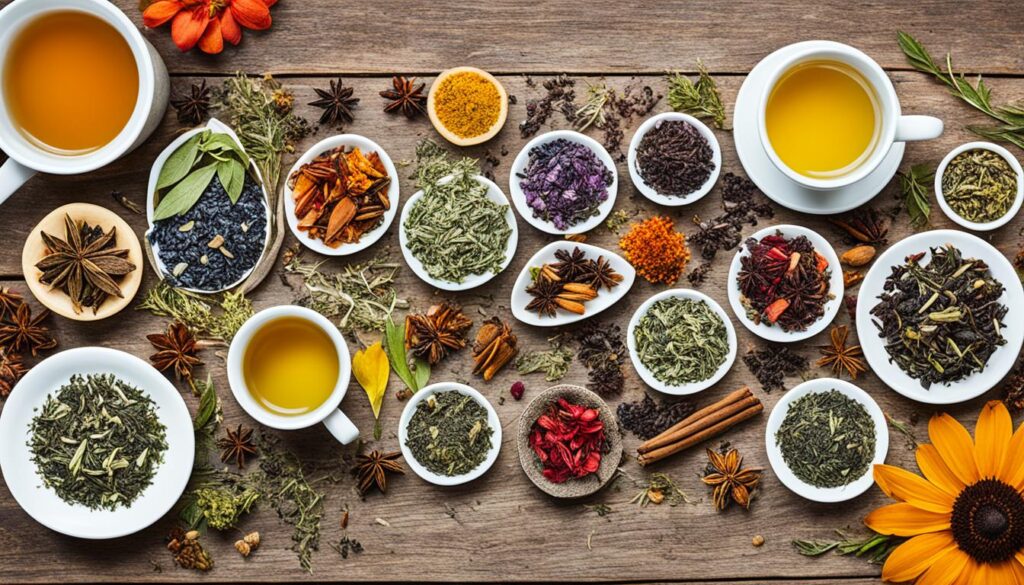
The decaffeination process usually leaves a tiny bit of caffeine, about 2-4 milligrams per cup. This small amount means you can enjoy a warm tea without the buzz. It’s perfect for the evening or if caffeine affects you easily.
Decaffeinated Teas: How Much Caffeine Really Remains?
Those who prefer less caffeine might like the CO2 high-pressure extraction method. This technique keeps the tea’s original flavor but removes most of the caffeine.
Herbal Teas: Naturally Free of Caffeine
Herbal teas are great because they lack caffeine entirely. Unlike tea leaves, chamomile, peppermint, and rooibos are made from various plants. This gives them unique flavors without any caffeine.
Comparing Caffeine in Yerba Mate to Traditional Teas
Yerba mate stands out among herbal teas because it has caffeine. It contains about half as much caffeine as coffee. This makes it a favorite in South America for those who want a mild energizer without coffee.
| Type of Tea | Average Caffeine Content (mg/cup) |
|---|---|
| Decaffeinated Tea | 2-4 |
| Herbal Tea | 0 |
| Yerba Mate | 35-85 |
Conclusion
Exploring the world of teas means understanding the caffeine levels in different teas. Each tea, from bold black to delicate white, has its own caffeine content. Some teas give a strong energy boost, while herbal ones are calming because they’re caffeine-free.
Learning about comparing caffeine in tea types is essential for tea lovers. It helps them know what each tea can offer, considering caffeine. This makes choosing a tea an informed choice, mixing pleasure and health.
The tea caffeine comparison shows there’s a perfect tea for everyone and every moment. It’s about finding balance between what you love and what’s good for you. This journey of discovery brings out tea’s flavors and health benefits, safely. The vast selection in the tea world means there’s always something new to try.
